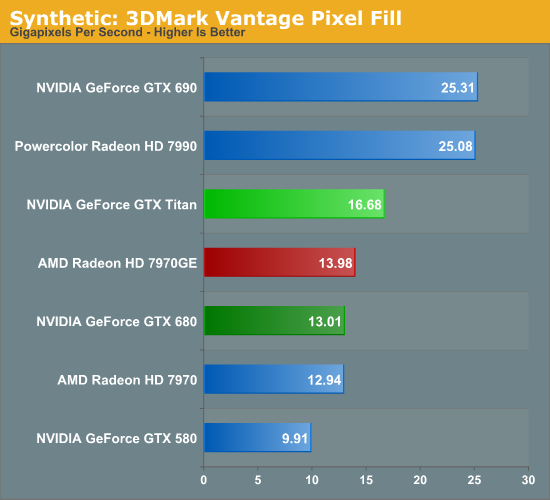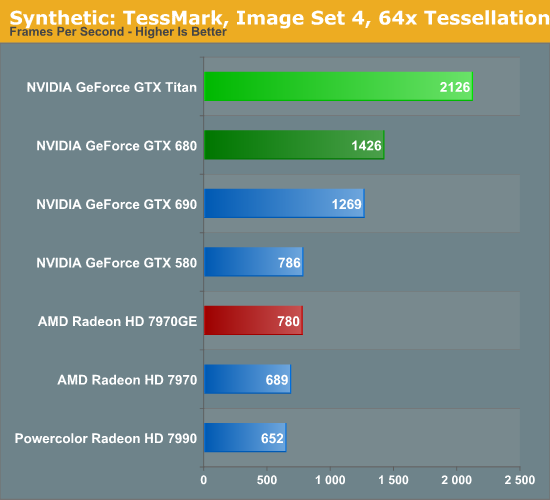NVIDIA’s GeForce GTX Titan Review, Part 2: Titan's Performance Unveiled
by Ryan Smith & Rahul Garg on February 21, 2013 9:00 AM ESTSynthetics
As always we’ll also take a quick look at synthetic performance to get a better look at Titan’s underpinnings. These tests are mostly for comparing cards from within a manufacturer, as opposed to directly comparing AMD and NVIDIA cards. We’ll start with 3DMark Vantage’s Pixel Fill test.

Pixel fill is a mix of a ROP test and a test to see if you have enough bandwidth to feed those ROPs. At the same time the smallest increase in theoretical performance for Titan over GTX 680 was in ROP performance, where a 50% increase in ROPs was met with a minor clockspeed reduction for a final increase in ROP performance of 25%.
The end result is that with gains of 28%, Titan’s lead over GTX 680 is just a hair more than its increase in theoretical ROP performance. Consequently at first glance it looks like Titan has enough memory and cache bandwidth to feed its 48 ROPs, which given where we’re at today with GDDR5 is good news as GDDR5 has very nearly run out of room.
Moving on, we have our 3DMark Vantage texture fillrate test, which does for texels and texture mapping units what the previous test does for ROPs.

Oddly enough, despite the fact that Titan’s texture performance improvements over GTX 680 were only on the range of 46%, here Titan is measured as having 62% more texturing performance. This may be how Titan is interplaying with its improved bandwidth, or it may be a case where some of the ancillary changes NVIDIA made to the texture paths for compute are somehow also beneficial to proper texturing performance.
Finally we’ll take a quick look at tessellation performance with TessMark.

Unsurprisingly, Titan is well ahead of anything else NVIDIA produces. At 49% faster it’s just a bit over the 46% theoretical performance improvement we would expect from the increased number of Polymorph Engines the extra 6 SMXes bring. Interestingly, as fast as GTX 580’s tessellation performance was, these results would indicate that Titan offers more than a generational jump in tessellation performance, nearly tripling GTX 580’s tessellation performance. Though at this time it’s not at all clear just what such tessellation performance is good for, as we seem to be reaching increasingly ridiculous levels.










337 Comments
View All Comments
Sufo - Thursday, February 21, 2013 - link
lol, you clearly haven't run a dual gpu setup.Veteranv2 - Thursday, February 21, 2013 - link
Such a shame. How you can you disregard all the dual GPU cards?Another biased review. I miss the time when Anand used to be objective. Now it is just a Intel/Nvidia propaganda site. Not even an objective final thoughts. It is really a shame. I feel sad.
Ryan Smith - Thursday, February 21, 2013 - link
Um? They're there. Along with 680 SLI and 7970GE CrossFire.processinfo - Thursday, February 21, 2013 - link
Act surprised? He means that in final thoughts you downplaying fact that Titan is slower than dual GPU cards. I agree with him. It seems biased, especially when later you talk about 3 way SLI with Titan that would have same issues like dual GPU cards. They cost the same or less and they are faster. For gaming this card brings nothing to the table. For $500-600 it would be different story.Ryan Smith - Thursday, February 21, 2013 - link
Ahh.So our editorial stance is that while SLI/CF are great, they should only be used to increase performance beyond what a single large GPU can accomplish. AFR comes with some very notable penalties, and while these are acceptable when you can go no bigger, we do not believe these are good tradeoffs to make otherwise.
It's the same reason why we didn't recommend cards like the GTX 560 Ti 2Win over the GTX 580.
http://www.anandtech.com/show/5048/evgas-geforce-g...
Simply put we'd rather have the more consistent performance and freedom from profiles that having a single GTX Titan provides, over the higher but also more unreliable performance of a GTX 690.
Alucard291 - Thursday, February 21, 2013 - link
Well its exactly as you said Ryan. Its overpriced and badly positioned in the market (except you used much kinder words - presumably to keep your paycheck)Its a nice, pointless consumer (that's a key word right here) gpu which brings benefits (what are those benefits exactly?) of overpriced compute performance to people who don't need compute performance.
Beautiful move Nvidia.
processinfo - Thursday, February 21, 2013 - link
It is not about recommendation. I prefer single GPU and no SLI configs myself.It is about a fact that it is just slower than anything with similar price tag.
This is card only for people who need both: fast gaming card and computing card in one (or for those who don't care about a price).
Hrel - Thursday, February 21, 2013 - link
I think it's about time you re-asses that stance. SLI/CF has come a long way in the past few years.Also, 1000 dollars for one card puts it so far out of consideration it doesn't even count as an option for single GPU use. Which was why he said "For $500-600 it would be a different story". For gaming this card is useless. For Compute it seems 7970GHE would be a better option too. Again, based solely on price. Performance is close enough it makes WAY more sense to just buy 2 of those for 860 bucks if you really need to do some serious GPU compute.
Ryan Smith - Thursday, February 21, 2013 - link
Actually we did re-assess our stance ahead of this article.Far Cry 3 came out and SLI didn't work correctly; it took a few NVIDIA releases to get it up to where it is today. That's exactly the kind of scenario that drives our existing stance.
CeriseCogburn - Thursday, February 21, 2013 - link
Yes, of course, forget mentioning the half decade of AMD epic failure in CF...It's just amazing what I read here. The bias is so glaring a monkey couldn't miss it.